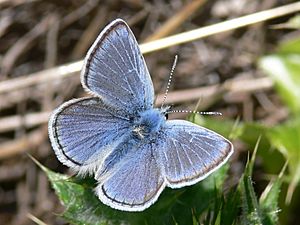Boisduval's blue facts for kids
Quick facts for kids Boisduval's blue |
|
|---|---|
 |
|
| Mission blue, male upperside. | |
 |
|
| Fender's blue, male underside. | |
| Scientific classification | |
| Genus: |
Icaricia
|
| Species: |
icarioides
|
| Subspecies | |
|
See text |
|
| Synonyms | |
|
|
The Boisduval's blue butterfly (scientific name: Icaricia icarioides) is a beautiful insect. It belongs to the Lycaenidae family, also known as the 'gossamer-winged butterflies'. You can find this butterfly in North America. There are 25 different types, or subspecies, of the Boisduval's blue.
This butterfly was first named by Jean Baptiste Boisduval in 1852. Scientists sometimes change a butterfly's scientific group. This helps them understand how different species are related. The Boisduval's blue has been placed in several groups over the years. Today, it is back in the Icaricia group. This decision was made after new studies looked at the butterflies' DNA.
Contents
Where Boisduval's Blue Butterflies Live
You can find Boisduval's blue butterflies across western North America. Their home stretches from southern Saskatchewan in Canada all the way to British Columbia. In the United States, they live throughout the western states.
What Boisduval's Blue Butterflies Eat
The young butterflies, called larvae or caterpillars, have a special diet. They love to eat plants from the Lupinus family. These plants are commonly known as lupines.
How Big Are They?
Boisduval's blue butterflies are not very big. Their wingspan, which is the distance from one wingtip to the other, ranges from 21 to 32 millimeters. That's about the length of a few pennies lined up!
Similar Butterflies
Sometimes, it can be tricky to tell different butterflies apart. Here are a couple of butterflies that look similar to the Boisduval's blue:
- Greenish blue (Icaricia saepiolus)
- Silvery blue (Glaucopsyche lygdamus)
Different Kinds of Boisduval's Blue
There are many different subspecies of the Boisduval's blue butterfly. Each one might have slight differences in looks or where they live. Here are some of the recognized subspecies:
- Icaricia icarioides evius
- Icaricia icarioides santana
- Icaricia icarioides moroensis
- Icaricia icarioides atascadero
- Icaricia icarioides pardalis
- Icaricia icarioides missionensis – This one is called the Mission blue.
- Icaricia icarioides pheres (This subspecies is no longer found, meaning it is extinct.)
- Icaricia icarioides parapheres
- Icaricia icarioides fenderi – This one is called the Fender's blue.
- Icaricia icarioides blackmorei - This one is called the Puget blue.
- Icaricia icarioides montis
- Icaricia icarioides helios
- Icaricia icarioides icarioides
- Icaricia icarioides eosierra
- Icaricia icarioides albihalos
- Icaricia icarioides inyo
- Icaricia icarioides argusmontana
- Icaricia icarioides panamintina
- Icaricia icarioides austinorum
- Icaricia icarioides fulla
- Icaricia icarioides pembina
- Icaricia icarioides lycea
- Icaricia icarioides sacre
- Icaricia icarioides nigrafem
- Icaricia icarioides buchholzi

